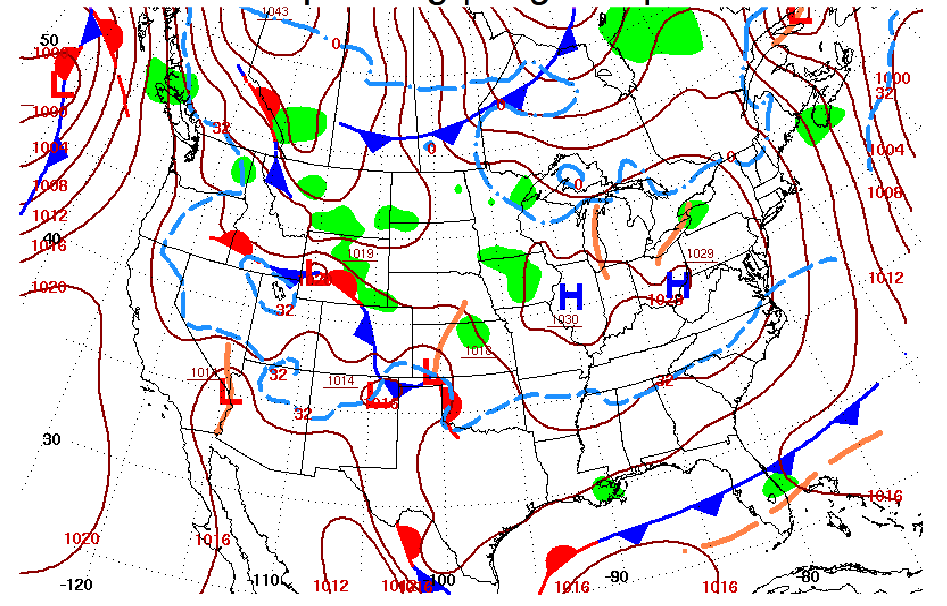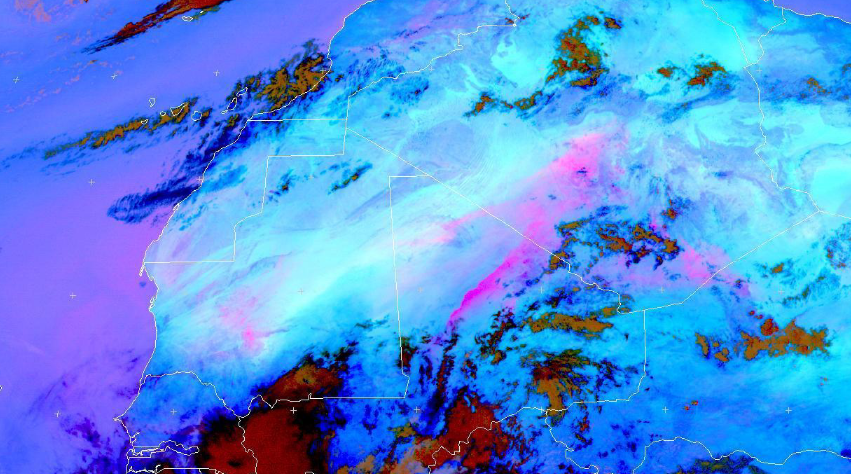Satellite skills and knowledge for operational meteorologist
Listed here are other resources related to Satellite skills and knowledge for operational meteorologist tag:
Note: click on an image to open the Resource
Gregory Carbin gives a presentation on the weather extremes of the winter 2014 in the US.
Length: 25 minutes.
The cool season months of 2014 (JFM) over the U.S. mainland can best be described as much colder than normal across portions of the Great Lakes, Northeast, and Midwest, and much drier and warmer than normal over the west coast, especially California. This talk offered a review of three aspects of the winter/early spring seasons. The first was a review of 12 UTC temperatures for every day in January across the continental U.S. and the relationship of some of the colder mornings with the longer-term record of January mornings back to 1979. The second event of note was the onset of exceptional drought in California. The third event, coming at the end of March, was a look at significant cyclogenesis off the U.S. eastern seaboard on March 25-26.
Hamidou Hama highlights the major socio-economic and environmental impacts of dust, focuses on the meteorological processes at various scales that are responsible for raising dust/sand storms in the arid Sahara Desert and the semi arid Sahel at its fringes.
Length: 40 minutes.
This presentation, after highlighting the major socio-economic and environmental impacts of dust, focuses on the meteorological processes at various scales that are responsible for raising dust/sand storms in the arid Sahara Desert and the semi arid Sahel at its fringes. The challenges facing the weather forecaster in forecasting such high impact weather phenomena and the importance of satellite remote sensing in their monitoring were also addressed here.
Helge Tuschy's talk offered an insight into the ingredients-based forecasting method, which assists an operational forecaster in preparing well ahead of an active thunderstorm day.
Length: 60 minutes.
This talk offered an insight into the ingredients-based forecasting method, which assists an operational forecaster in preparing well ahead of an active thunderstorm day. Mr. Tuschy also gave an overview about certain ingredients which could result in heavy rainfall and flash flooding (due to deep moist convection). He ended his talk with a short overview about ESTOFEX, the European Storm Forecast Experiment.
Hamidreza Mosaffa presents a study that aims 1) to develop the long-term climatological SM2RAIN datasets for the period of 1998–2020 by merging two rainfall SM2RAIN products including SM2RAIN-CCI and SM2RAIN-ASCAT, and 2) to the analysis of drought based on standardized precipitation index over the USA.
Investigation of drought variability requires long term rainfall dataset with high spatial and temporal resolution. The goal of this study are as follow: 1) to develop the long-term climatological SM2RAIN datasets for the period of 1998–2020 at 0.25° spatial and monthly temporal resolution by merging two rainfall SM2RAIN products including SM2RAIN-CCI and SM2RAIN-ASCAT, and 2) to the analysis of drought based on standardized precipitation index over the USA. Results indicated that the most significant decreases in the monthly rainfall trends appear in November. In addition, drought occurred during 2003, 2007, and 2012 over most parts of the USA.
Leo Pio D'Adderio analyses the performances of the H SAF precipitation products during the Mediterranean cyclone Apollo.
This work analyses the performances of the H SAF precipitation products during the Mediterranean cyclone Apollo. The cyclone Apollo occurred between October 25th and October 29th, 2021 with its maximum on October 28th and 29th when it approached the coasts of Sicily causing floods and damages to civil structures. The present work aims to describe the cyclone evolution by exploiting the satellite-based Level 2 and Level 3 H SAF precipitation products. The analysis focuses on the reconstruction of the precipitation pattern and of the quantitative amount thanks a direct comparison with ground-based measurements.
Emanuel Dutra presents an overview of the LSA SAF ET products with particular focus on the use of HSAF soil moisture in operations (H14 and future H26) and in the production of the climate data record (H141).
Evapotranspiration (ET) is a key component of the Earth System coupling land-atmosphere exchanges of water, energy and carbon. Due to the complex nature of the processes involved (radiation, boundary layer turbulence, vegetation status, soil moisture) it is very challenging to observe (locally and from Satellite) and to model. LSA SAF evapotranspiration product takes advantage of satellite radiation and soil moisture estimates to diagnose ET using a surface energy balance approach. This talk will present an overview of the LSA SAF ET products with particular focus on the use of HSAF soil moisture in operations (H14 and future H26) and in the production of the climate data record (H141).
Regis Borde from Eumetsat explains in his presentation how winds are derived from polar orbiting satellites in the Arctic and Antarctic region.
Atmospheric Motion Vectors (AMVs) have been derived from geostationary satellites since late seventies. In 2001, an experimental polar wind product has been developed at the University of Wisconsin-Madison’s (CIMSS) using imagery from MODIS instrument on NASA’s Terra satellite. Filling the lack of observational data over Polar Regions this product demonstrated a global positive impact on the forecast not only over polar areas. Following the initial CIMSS developments, EUMETSAT recently started to extract polar winds from METOP AVHRR instrument. Regis Borde´s session will provide some general information about the current status of polar winds product and about its extraction. The general methodology to derive polar winds from satellite images is mainly based on the heritage used for geostationary satellites, but some specific problems had to be considered due to larger timeliness between consecutive images, to characteristics of the instruments and to specificities of polar areas atmosphere.
Joseph Sienkiewicz provides an overview of the measuring principles of scatterometers on polar orbiters. The presentation concludes on practical examples showing also attenuation effect by rain droplets.
Ocean surface vector winds derived from polar satellite based scatterometers (radars) allow marine forecasters to view high resolution wind fields over the global ocean. Operational forecasters first access to near real time ocean vector winds began in the early 1990s with the launch of ERS-1 and followed by ERS-2, NASA's NSCAT and QuikSCAT. Of these instruments QuikSCAT, during its ten year life span, provided a wide swath capability allowing forecasters to see entire storms in a single swath. Today, ASCAT on Metop-A, OSCAT on Indian Space Research Organisation (ISRO) OceanSat-2 satellite and in the near future ASCAT-B on Metop-B will continue to provide global coverage. Scatterometer winds provide forecasters a high resolution "sea" truth, give an enhanced situational awareness, the ability to assess the validity of numerical model initial conditions and short term forecasts, and the location and intensity of warning criteria winds. This talk will discuss the above issues by giving examples and also discuss how to interpret remotely sensed ocean winds.
Nan Hao from DLR gives an overview on ozone and other trace gases products from the O3M SAF. The presentation is completed by numerous examples.
This lecture focuses on the ozone and other minor trace gas products, such as NO2 and SO2, from the GOME-2 and IASI instruments on MetOp. These products are developed in the framework of EUMETSAT’s Satellite Application Facility on Ozone and Atmospheric Chemistry Monitoring (O3M-SAF), as part of EUMETSAT’s Polar System (EPS) Ground Segment. The O3M-SAF is responsible for the algorithm development, the operational processing, dissemination and archiving of the products, as well as providing User Services. The ozone and minor trace gas products from GOME-2 and IASI are used in research of atmospheric composition, like ozone loss, dynamics, anthropogenic effects, and in applications of environmental security, like monitoring of volcanic eruptions and pollution.
This webcast contains 2 presentations: The first is from Lourdes Bugalho who talks about the forest fire combined risk index (ICRIF) and the second presentation is from Renata Libonati about monitoring burnt areas from polar orbiting satellites.
First part:
Forest fires are one of the most devastating natural disasters that often occur in mainland Portugal during the summer, with an impact on the economy, environment and climate. The Institute of Meteorology, currently Portuguese Institute of the Sea and the Atmosphere (IPMA, Instituto Português do Mar e da Atmosfera) has long made efforts to provide daily information on the risk of forest fires. Currently, IPMA daily runs an index of forest fire risk based on FWI (Fire Weather Index), developed by the Canadian Forest Service. This new index, ICRIF (Indice Combinado de Risco de Incêndios Florestais ) combines FWI with the type and condition of vegetation, called structural risk, being the vegetation type based on CORINE 2000 (CLC2000) and the vegetation conditions based on daily observation of NDVI (Normalized Difference Vegetation Index), retrieved from the AVHRR radiometer.
Second part:
Brazilian Amazonia together with the adjacent savanna (Cerrado) presents a huge number of fire events every year. In such context, accurate information about location and extent of burned area is required and of particular interest for the scientific communities dealing with meteorological and climate models in what concerns reliable estimations of biomass burned. Accordingly, an effort has been made by the scientific community to develop thematic products of burnt areas. In such context, this presentation will provide an overview of INPE/Brazil currently efforts in monitoring burned areas. The initiative is based on the (V,W) burned index. The index uses daily reflectance obtained from the 1km MODIS Level 1B calibrated radiance from bands 2 (NIR) and 20 (MIR). An overview will be given of results obtained and operational applications will be shown.
Go to Webcast (first part from L. Bugalho) ...
Go to Webcast (second part from R. Libonati) ...
Powerpoint (first part from L. Bugalho) ...
Powerpoint (second part from R. Libonati) ...
Nuno Moreira from IPMA guides you through the web sites mentioned in the presentations during the Polar Satellites Week.
In this session you will be taken on a website tour, visiting pages where polar satellite products referred during the whole EUMETRAIN Polar Satellite Week can be visualized. “Web-Visits” will naturally include EUMETSAT or NOAA pages and it will be an opportunity to make a wrap-up on the contents previously discussed...
Piet Stammes from KNMI talks about aerosol retrieval with GOME-2 instrument onboard MetOp satellites since 2006. Intercomparison with other instrument data and examples round up the presentation.
Aerosols are small liquid or solid particles in the atmosphere, like soil dust, sulphate and nitrate droplets, organic compounds, volcanic ash, etc.. Aerosols affect weather and climate by reflection and absorption of sunlight, by affecting cloud formation and precipitation, and by reducing visibility. Satellite detection of aerosols is often difficult because of the relatively weak reflectance of aerosols as compared to clouds and the background reflection of the underlying surface. Using UV-Visible spectrometers like OMI and GOME-2, UV absorbing aerosols like biomass burning smoke, volcanic ash and desert dust can be detected, even in cloudy cases and over land surfaces. In this presentation the current and future aerosol products from GOME-2 available from the O3MSAF will be introduced.












